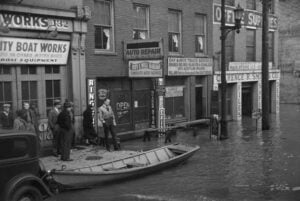The Canal That Built Chicago
In 1848, the 96 mile, Illinois and Michigan Canal opened, linking Lake Michigan to the Illinois River. Like the Erie Canal, which opened two decades earlier, the I&M Canal revolutionized trade and travel in the United States.

exc-5fcee628798354522d01ba26
In 1848, the 96-mile, Illinois and Michigan Canal opened, linking Lake Michigan to the Illinois River. Like the Erie Canal, which opened two decades earlier, the I&M Canal revolutionized trade and travel in the United States. It connected the Atlantic Ocean with the Mississippi River. With the new canal, freight from New York could get to St. Louis in 12 days instead of the 30-40 days it took on the Ohio River route (which involved land travel across the Appalachian Mountains). Meanwhile, the canal catapulted Chicago to the status of an economic powerhouse.
Origins
In the 1670s, French explorer Louis Joliet and his companion Father Marquette explored the Illinois River. At the origin of the river, they took the Chicago Portage to the Chicago River and eventually Lake Michigan. The Chicago Portage was used by Native Americans for centuries. Portage trails were narrow land routes between water sources, usually rivers. Sometimes they were marshland. If the water was high enough, they could sometimes be traversable by canoe. But often portage trails were dry and travelers had to carry their boats and other belongings on land. Joliet remarked that a future canal should be built along the trails connecting the Illinois River with the Chicago River.
This wasn’t forgotten. In 1803, with the Chicago Portage in mind, the United States built Fort Dearborn on the current site of Chicago on the Chicago River. (The fort was later involved in the War of 1812)
A survey of the portage was commissioned in 1816, which led to a proposal for a canal. US officials knew about the economic and strategic benefits of a canal, and they pushed the proposed state of Illinois’ boundaries north of the canal. In 1830, the Canal Commissioners platted the towns of Ottawa and Chicago (which had a population of around 50) and began selling canal land at $1.25/acre to finance the canal construction. In the 1830s, Illinois lawmakers including Abraham Lincoln championed the canal project. The idea of a canal brought land speculators and settlers from the East. By 1836, Chicago’s population had grown to 4,000.
Construction on the canal began in 1836. However, workers halted construction for several years due to Illinois almost being bankrupt. The majority of workers were Irish Immigrants (many of them had worked on the Erie Canal). Work conditions were poor, which killed some of the workers in the process. It eventually opened in 1848 at a total cost of $6,170,226.
The rise of Chicago
After the completion of the canal, Chicago became one of the fastest-growing cities in the world. Germans, Italians, Poles, Swedes, and many other immigrants were drawn to Chicago. During the 12 years, it took to build the canal, the city’s population grew from 4,000 to 20,000. From 1848 – 1860, it quintupled again to 112,172 (This was also helped by the addition of railways.) By 1900 over 1.6 million people were living in the city. New luxury goods from New York and New England were available to Illinois residents including calico, furniture, and woolen blankets. Shipments via New Orleans brought sugar, oranges, and other goods to Chicago kitchens.
By 1869, Chicago was the busiest port in the United States. (Chicago had more ships in the City’s harbor than New York, San Francisco, New Orleans, Boston, Baltimore, and Philadelphia combined.) This led to Chicago replacing the port city of St. Louis as the economic powerhouse of the Midwest and threatened St. Louis’s status of “Gateway to the West.” Although, it opened up new trade for St. Louis also.
Other towns along the canal also boomed including Lockport, Joliet, Morris, Ottawa, and LaSalle. Grain elevators lined the canal. Pine trees from Wisconsin filled up Chicago lumberyards. Mined coal, limestone, and grain were transported across the country via Chicago. Travelers headed out west from the east coast stopped through Chicago, including thousands of gold seekers traveling to California for the gold rush.
However, the canal also had negative effects, most notably, sanitary problems. With Chicago’s rise in population, the waste piled up in the canal. Thousands died of waterborne diseases like cholera and typhoid. To fix the sanitary issues, workers deepened the I&M Canal. This reversed the river and carried sewage away from Lake Michigan.
The canal’s decline
By the late 1890s, freight traffic had diminished, and by 1914 it mostly ceased. In 1933, the canal was replaced by the Illinois Waterway. In 1984, the canal area was designated the first National Heritage Corridor by US Congress.
Today, much of the Illinois and Michigan Canal has been filled in. But a large chunk of the canal is a park with canoeing, hiking, and biking trails. It also includes museums and historical canal buildings.
Sources used:
https://www.csu.edu/cerc/researchreports/documents/IMCanalShapesHistory2004.pdf
https://iandmcanal.org/about-this-place-history/
http://www.encyclopedia.chicagohistory.org/pages/626.html
https://iandmcanal.org/a-story-with-national-and-international-significance/







1 thought on “The Canal That Built Chicago”